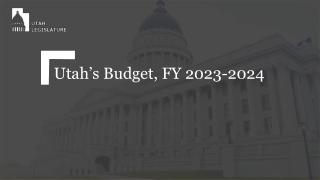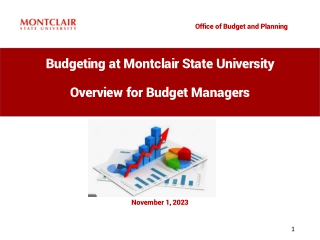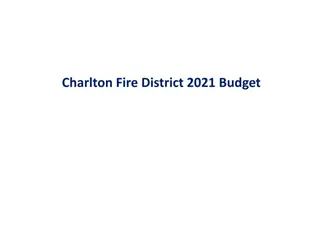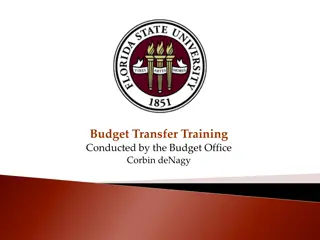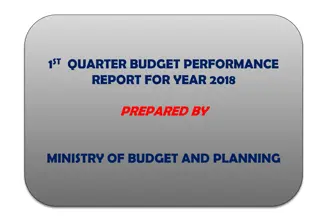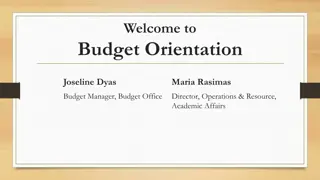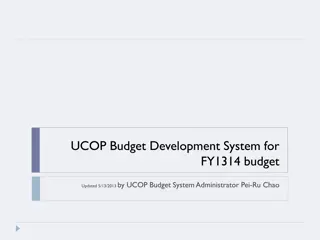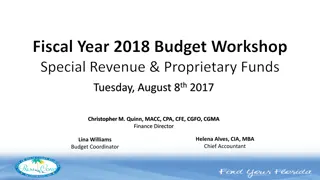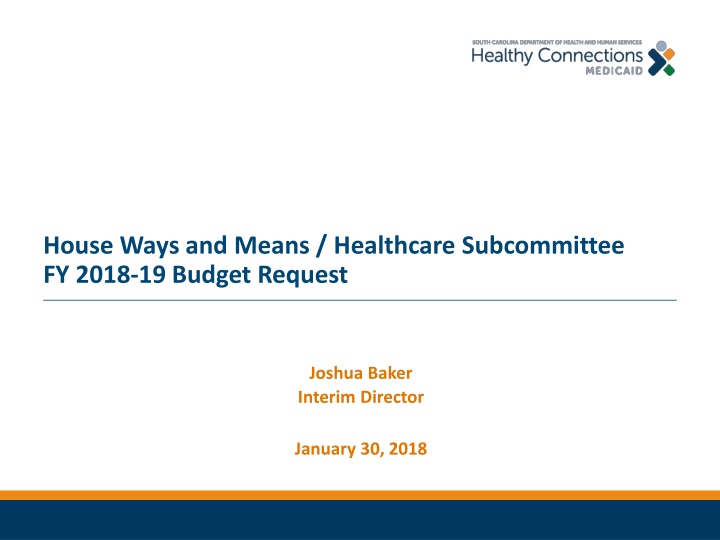
Healthcare Subcommittee FY 2018-19 Budget Request Overview
Explore the detailed breakdown of the House Ways and Means/Healthcare Subcommittee's budget requests for FY 2018-19. Review the financial status, guiding principles, and proposed changes in funding allocations, emphasizing the need for fiscal responsibility and strategic planning.
Download Presentation

Please find below an Image/Link to download the presentation.
The content on the website is provided AS IS for your information and personal use only. It may not be sold, licensed, or shared on other websites without obtaining consent from the author. If you encounter any issues during the download, it is possible that the publisher has removed the file from their server.
You are allowed to download the files provided on this website for personal or commercial use, subject to the condition that they are used lawfully. All files are the property of their respective owners.
The content on the website is provided AS IS for your information and personal use only. It may not be sold, licensed, or shared on other websites without obtaining consent from the author.
E N D
Presentation Transcript
House Ways and Means / Healthcare Subcommittee FY 2018-19 Budget Request Joshua Baker Interim Director January 30, 2018
FY 2016-17 Year-End & FY 2017-18 Year-to-Date 2
FY 2016-17 Year-End FY 2017 State General/Other Funds 1,759,264,674 $ 228,576,085 $ $ 131,028,228 $ 2,144,323,897 $ 2,201,930,817 $ 97.4% FY 2017 Total Funds Incl. Federal 5,944,812,700 $ 795,980,706 $ 67,581,130 $ 295,556,559 $ 7,103,931,095 $ 7,161,538,015 $ 99.2% Medicaid Assistance State Agencies Personnel & Benefits Medical Contracts & Other Operating Total Expenditures Revenues Received Percent Expended 25,454,910 Department ended FY 2017 close to target, cash surplus was 2.6% of state funds, 0.8% of total appropriation Much of the gap is associated with one-time events Moratorium on the health insurer tax (HIT) for SFY 2017 RMMIS schedule re-baselined 3
FY 2017-18 2nd Quarter FY 2018 Realigned Appropriation 6,303,994,331 $ 871,508,090 $ 80,320,930 $ 367,311,413 $ 7,623,134,764 $ FY 2018 Actuals (thru 12.31.17) 3,009,224,027 $ 346,747,275 $ 36,947,244 $ 124,926,755 $ 3,517,845,301 $ % Medicaid Assistance State Agencies & Other Entities Personnel & Benefits Medical Contracts & Operating Total 47.7% 39.8% 46.0% 34.0% 46.1% Department spent 46% of its annual budget during the first six months of the fiscal year Medical Contracts & Operating is typically under budget until late in the fiscal year Large annual events such as supplemental teaching physician payments and HIT submissions will occur later in the fiscal year State agency billings for match continue to decrease with carve-ins On track for a break-even year 4
FY 2018-19 Budget Request Guiding principles for the request: Preserves the same general principles as last year Keep reserves above 3% through the planning horizon Fund annualizations Updates financial baselines to reflect agency experience $23 million increase to other funds revenues Lower targets for net managed care rate adjustments Limited proposals for targeted rate and program changes 6
FY 2018-19 Executive Budget General Funds All Funds Recurring Requests Total Annualization/MOE Autism Rate Increase BabyNet Appropriation Transfer from DDSN DDSN First Slots Appopriation Transfer Opioids FY 2018-19 Recurring Changes $ $ $ $ $ $ 26,416,551 3,848,880 11,402,071 (1,368,235) 4,350,000 44,649,267 $ $ $ $ $ $ 7,173,480 13,272,000 11,402,071 (1,368,235) 15,000,000 45,479,316 Non-Recurring Request Non-Recurring: MMIS $ 7,741,075 $ 7,741,075 7
FY 2018-19 Budget Request Most funding is for annualizations, but these would be new items: CHIP funding ($52M general funds, Not in Executive Budget) 6-year reauthorization approved on 1/23/2018 Appropriation transfers First slots to South Carolina Department of Disabilities and Special Needs (SCDDSN) and BabyNet from SCDDSN - Net neutral to the state SCDDSN provided transfer amount in response to proviso 117.133 Autism rate increase ($3.8M general funds) Assumed utilization increase along with a change to rate structure Opioid dependence interventions ($4.3M general funds) 8
Autism New state plan Autism Spectrum Disorder (ASD) services took effect July 1, 2017 Services included in the managed care benefit for MCO enrollees Incremental rate increase for lead and line therapy Registered Behavior Technician (RBT) certification required for line therapists Pervasive Developmental Disorder (PDD) waiver sunset on December 31, 2017 As of January 5th, 128 autism providers within 20 provider groups enrolled in SC Medicaid FY 2018-19 original request included an increase for line therapy and blended supervision into the rate Agency updating rate methodology to reflect cost-driven structure Members of the provider community have been invited to provide cost and utilization data to help mold rates Rates are being indexed against standard cost of employment and overhead data Original line rate proposed at $24.18, final rate likely to land around $27.00 9
Opioid Dependence Reexamining existing state plan interventions for effectiveness Screening, Brief Intervention and Referral to Treatment (SBIRT) utilization among existing providers; expansion to new groups Full-benefit Medicaid members have access to evidence-based MAT today (Buprenorphine and Naltrexone) Telemedicine in rural or underserved communities Evidence-based interventions to prevent, identify, and treat Limiting payment for extended or inappropriate prescriptions Increased access to medication assisted treatment (MAT) in community settings Awaiting results of study efforts and executive guidance The Governor organized an opioid task force in 2017 SC House published an Opioid Abuse Prevention Study draft in early January Some interest in increased inpatient interventions Common policies among payers creates one set of rules for providers 10
FY 2018-19 Proviso Changes Amend four provisos: 117.98 GP: BabyNet Quarterly Reports Amend The requested amendment deletes First Steps to School Readiness as a reporting entity since BabyNet is now within SCDHHS and deletes reference to the reporting template being developed by agencies since the template format is already in place. 117.133 GP: BabyNet Amend The requested change is a technical amendment to update the reporting date. 33.20 Medicaid Accountability and Quality Improvement Initiative Amend Although this proviso directs a variety of expenditures, it does not provide or specifically identify a source of funding for this work. The proposed revisions to this proviso would reduce expenditures by approximately $1.1 million (100% state funds) compared to FY 2017-18 levels. 33.24 SCDHHS: BabyNet Compliance Amend The requested change is a technical amendment to update the reporting date. 11
FY 2018-19 Proviso Changes Delete: 33.25 SCDHHS: Personal Emergency Response System Delete This proviso was vetoed by the Governor for FY 2017-2018. Agency currently covers personal emergency response systems; proviso directs the agency to release and RFP for nurse triage services, pursuant to a waiver. SCDHHS has reviewed 22 states with similar waivers and found none that currently include nurse triage as part of the personal emergency response system. The agency is in process of preparing the waiver pending the final outcome of the veto. If waiver is submitted in FY 2018, proviso will be unnecessary in 2019. Agency is conducting evaluation of nurse triage pilot under current medical contracts. 12
Full-Benefit Enrollment 1,100,000 1,000,000 900,000 800,000 700,000 600,000 500,000 400,000 300,000 200,000 100,000 - Jan-15 Mar-15 May-15 Jul-15 Sep-15 Nov-15 Jan-16 Mar-16 May-16 Jul-16 Sep-16 Nov-16 Jan-17 Mar-17 May-17 Jul-17 Sep-17 Nov-17 Children Other Adults Disabled Adults Elderly 14
Eligibility and Enrollment Systems Inserted additional data sources to worker queues to avoid unworked applications Reprioritized work in queues to clear oldest and highest priority work Implemented a new systems integrator to finalize MAGI eligibility system replacement Process and staffing Staffing statewide processing centers for income-based and long-term care applications Long-term care application assistance contract awarded Exception and escalation for high-need/high-risk applications Member contact center Since August 1, performance improvement has been significant Maximum wait times dropped from >4 hours to 30 minutes Abandoned calls have dropped from >50% to <10% Customer satisfaction results of 87-98% o o o Interactive voice response (IVR) system allows self service and improves call routing and resolution 15
CHIP Authorization Authorization for CHIP funding initially ended September 30, 2017 SC was using unspent FFY 2017 CHIP allotment to continue operations As part of agreement to end government shutdown, CHIP funding was re-authorized through FFY 2023 SC CHIP funding will continue at 100% through FFY 2019 FMAP will then step down over next two federal fiscal years to its level prior to 2010 ACA, which is approximately 80% in SC 17
Enterprise Pricing Agency is conducting a comprehensive review of service pricing and fee schedules throughout 2018. Goal is to consolidate, modernize, and update fee schedules for professional services and waivers. Rate and code updates will happen on a January/July schedule to coincide with managed care rate setting cycles. Nominal rate adjustments may happen off-cycle from appropriations. Material changes will be submitted for approval by appropriators. 18
Long-term Care Eligibility Addressing internal productivity by assigning decision ownership to individual caseworkers. Eligibility Cases by Employee Interaction (24 Months) 1,600 1,400 1,200 1,000 # of cases 800 600 400 200 - 3 4 5 6 7 8 9 10 11 12+ # of times pended 19
BabyNet Transition BabyNet transition was effective July 1, 2017 Payment systems are in transition Systems development is underway to migrate from BRIDGES to MMIS Payment delays are resolved; service payment is current net 30 days Still finding providers with long-term problems; plan to send in an independent auditor to Jasper to reconcile accounts Hiring of a new Part-C state coordinator is underway Proviso 33.24 report to General Assembly has been delivered SC Selected for intensive technical assistance by US Department of Education Deficiencies are known and longstanding data lags 1 to 2 years Timeliness of service, timeliness of determination, and financial controls 20
Psychiatric Residential Treatment Facilities (PRTFs) Beginning July 1, 2017, PRTF services included as part of managed care benefit All PRTFs are contracting with or entering into single case agreements with the MCOs with a few exceptions Department continuing to work with PRTFs as a whole and address any issues FY 2017 average length of stay was 155 days Of the 1,150 unique individuals receiving PRTF services in FY 2017, 136 individuals had been in a PRTF program for 365 days or longer The max cumulative number of days an individual spent in a PRTF was 1,461 PRTFs in South Carolina have a total of 668 beds available South Carolina residents make up 56% of the available beds Excluding 3 outlier facilities, SC residents make up 3 out of 4 of available beds o 21
Rehabilitative Behavioral Health Services (RBHS) In July 2014, the Department eliminated prior authorizations for RBHS and assumed responsibility for supplying state match in most cases On July 1, 2016, the Department carved RBHS services into the managed care service array The moratorium on enrolling new providers is still in place pending analysis of post carve-in utilization data Actions against RBHS practices are continuing 45 group providers terminated or excluded 36 individuals referred to Attorney General 3 convictions, 3 under indictment Over $14M identified recoupments to date 22
Healthy Outcome Plans (HOP) HOPs receive revenue, pursuant to legislative proviso, from several streams. These include payment for each enrollee being actively managed with a current plan of care, hospital rate increase and FQHCs In a pre/post analysis conducted by the University of South Carolina Institute for Families in Society (IFS), comparing a 12 month pre-HOP period to participants with 19-24 months of enrollment: 65% reduction in emergency department (ED) cost, representing an average reduction of $1,373 per participant driven by a 67% decrease in the number of ED visits 62% reduction in mean inpatient hospital cost, representing an average reduction of $2,956 per participant driven by a 67% decrease in the number of inpatient hospital stays. Enrollment update, as of November 30, 2017 14,444 HOP participants against an FY 2017-18 goal of 14,591 96% of enrollees have a developed care plan 23
Home & Community Based Services (HCBS) CMS established new standards for waiver services and settings in a 2014 final rule compliance is required by March 2022 Statewide transition plan received initial approval in November 2016 South Carolina was one of the first states to receive approval Final approval should occur after completion of site visits 1,421 in total; review is 97% complete Only one facility to date has been deemed unable to meet compliance 24
Replacement MMIS and MMRP MMRP: Member Management Replacement Project Project Module Curam HCR Curam CGIS NoSQL ePortal MESI PBA BIS TPL Dental ASO Care Call MVI Status (Completion) In Development (Jul 2018) In Procurement In Development (Jan 2018) Operational (Sep 2017) In Procurement Operational (Nov 2017) In Development (Dec 2018) In Development (Apr 2018) Vendor Selected Vendor Selected RFP release Q2 CY 2018 Vendor Selected MMRP MES MES: Medicaid Enterprise System RMMIS: Replacement Medicaid Management Information System RMMIS 25
Medicaid Work Requirement On January 11, 2018, CMS provided new guidance that created an avenue for States to condition Medicaid eligibility on work and community engagement Policy Requirements: Alignment with SNAP and TANF Populations Subject to Work Requirements Protected Populations Range of Work & Community Engagement Activities Beneficiary Supports Attention to Market Forces & Structural Barriers Impact to SC: Fewer than 5K full-benefits members would be eligible for work requirement Approximately 185K limited members would be eligible for work requirement 26

